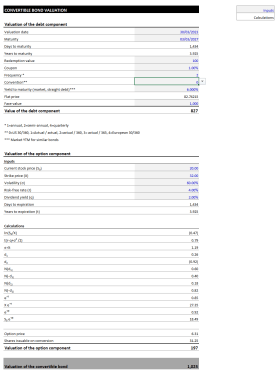
Originally published: 27/04/2023 15:09
Publication number: ELQ-84374-1
View all versions & Certificate
Publication number: ELQ-84374-1
View all versions & Certificate

EV to EqV: Convertible bond valuation
Valuing a convertible bond using both traditional bond valuation techniques and the Black-Scholes option pricing model
Diverse background in finance, policy-making, and international affairs, with a focus on investment banking, corporate finance, public finance, and multilateral development finance.Follow
company valuationcapital structureconvertible bond valuationenterprise to equityblack-scholestraditional bond valuation
Description
After completing a discounted cash flow (DCF) analysis to value operations, as well as valuing non-operating assets, in order to calculate equity value you need to deduct from the Enterprise value the value of debt, debt equivalents and/ or hybrid claims.
Some of the hybrid claims you fill often find are employee stock options (ESOs), warrants or convertible instruments.
Convertible instruments, such as convertible bonds or preferred stock, offer investors the option to convert the security into a predetermined number of common shares. This feature provides investors with the opportunity to benefit from the upside potential of the underlying equity while still receiving the regular interest or dividend payments associated with the bond or preferred stock.
The conversion ratio is the number of shares of common stock that can be obtained by converting one convertible bond. The conversion price is the price at which the bonds can be converted into common stock. The conversion premium is the difference between the market price of the convertible bond and the conversion price.
One common approach to valuing convertible instruments is to use a combination of traditional bond valuation techniques and option pricing models. The traditional bond valuation approach involves discounting the future cash flows of the instrument at a discount rate that reflects the issuer's creditworthiness and the prevailing interest rates in the market. This approach helps to determine the bond's present value and provides a baseline value for the convertible security.
The option pricing model, on the other hand, considers the value of the conversion option embedded in the convertible security. The model takes into account factors such as the volatility of the underlying equity, the time to maturity, the strike price of the conversion option, dividend yield, and risk-free rate. This approach helps to determine the value of the conversion option and provides an estimate of the potential upside that the investor can achieve by converting the security into equity.
This simple template applies the Black-Scholes valuation method to value the conversion option of a convertible instrument and the traditional bond valuation approach to value the debt component.
After completing a discounted cash flow (DCF) analysis to value operations, as well as valuing non-operating assets, in order to calculate equity value you need to deduct from the Enterprise value the value of debt, debt equivalents and/ or hybrid claims.
Some of the hybrid claims you fill often find are employee stock options (ESOs), warrants or convertible instruments.
Convertible instruments, such as convertible bonds or preferred stock, offer investors the option to convert the security into a predetermined number of common shares. This feature provides investors with the opportunity to benefit from the upside potential of the underlying equity while still receiving the regular interest or dividend payments associated with the bond or preferred stock.
The conversion ratio is the number of shares of common stock that can be obtained by converting one convertible bond. The conversion price is the price at which the bonds can be converted into common stock. The conversion premium is the difference between the market price of the convertible bond and the conversion price.
One common approach to valuing convertible instruments is to use a combination of traditional bond valuation techniques and option pricing models. The traditional bond valuation approach involves discounting the future cash flows of the instrument at a discount rate that reflects the issuer's creditworthiness and the prevailing interest rates in the market. This approach helps to determine the bond's present value and provides a baseline value for the convertible security.
The option pricing model, on the other hand, considers the value of the conversion option embedded in the convertible security. The model takes into account factors such as the volatility of the underlying equity, the time to maturity, the strike price of the conversion option, dividend yield, and risk-free rate. This approach helps to determine the value of the conversion option and provides an estimate of the potential upside that the investor can achieve by converting the security into equity.
This simple template applies the Black-Scholes valuation method to value the conversion option of a convertible instrument and the traditional bond valuation approach to value the debt component.
This Best Practice includes
1 excel spreadsheet

